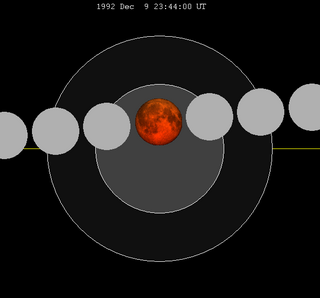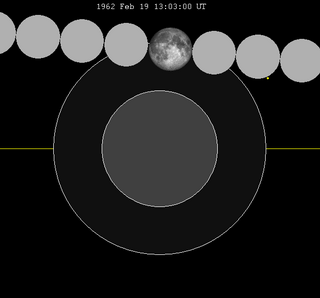
A penumbral lunar eclipse took place on Wednesday, August 15, 1962. [1]

A penumbral lunar eclipse took place on Wednesday, August 15, 1962. [1]
| Ascending node | Descending node | |||||
|---|---|---|---|---|---|---|
| Saros | Date Viewing | Type Chart | Saros | Date Viewing | Type Chart | |
| 102 | 1958 Apr 4  | Penumbral | ||||
| 112 | 1959 Mar 24  | Partial | 117 | 1959 Sep 17  | Penumbral | |
| 122 | 1960 Mar 13  | Total | 127 | 1960 Sep 5  | Total | |
| 132 | 1961 Mar 2  | Partial | 137 | 1961 Aug 26  | Partial | |
| 142 | 1962 Feb 19  | Penumbral | 147 | 1962 Aug 15  | Penumbral | |
| Last set | 1958 May 3 | Last set | 1958 Oct 27 | |||
| Next set | 1963 Jan 9 | Next set | 1962 Jul 17 | |||

A total lunar eclipse took place on Friday, May 16, 2003, the first of two total lunar eclipses in 2003, the other being on November 9, 2003. A shallow total eclipse saw the Moon in relative darkness for 52 minutes and 3.1 seconds. The Moon was 12.938% of its diameter into the Earth's umbral shadow, and should have been significantly darkened. The partial eclipse lasted for 3 hours, 15 minutes and 3.1 seconds in total. Occurring only 0.5 days after perigee, the Moon's apparent diameter was 6.2% larger than average. At greatest eclipse the Moon was only 357,693 km from the Earth, making it a Super Full Moon.

A total lunar eclipse took place on Wednesday, December 9, 1992, the second of two lunar eclipses in 1992, the first was a partial lunar eclipse on Monday, June 15.

A partial lunar eclipse took place on Saturday, April 15, 1995, the first of two lunar eclipses in 1995, the second being with a penumbral lunar eclipse on Sunday, October 8.

A total lunar eclipse took place on Thursday, December 30, 1982. A shallow total eclipse saw the Moon in relative darkness for 1 hour 3 seconds. The Moon was 18% of its diameter into the Earth's umbral shadow, and should have been significantly darkened. The partial eclipse lasted for 3 hours and 16 minutes in total. This was a supermoon since perigee was on the same day. It was also a blue moon, the second full moon of December for the eastern hemisphere where the previous full moon was on December 1. Since total lunar eclipses are also known as blood moons, this combination is known as a super blue blood moon.

A partial lunar eclipse took place on Monday, June 15, 1992, the first of two lunar eclipses in 1992, the second being with a total lunar eclipse on Wednesday, December 9.

A penumbral lunar eclipse took place on Friday, July 26, 1991, the third of four lunar eclipses in 1991. This was the 2nd member of Lunar Saros 148. The previous event was on 15 July 1973, and the 1st eclipse of the series. The next event was on 6 August 2009.

A penumbral lunar eclipse took place on Wednesday, January 30, 1991, the first of four lunar eclipses in 1991.
A penumbral lunar eclipse took place on Tuesday, May 15, 1984, the first of three lunar eclipses in 1984. This was a deep penumbral eclipse, with the southern limb of the Moon close to the Earth's shadow.
A penumbral lunar eclipse took place on Sunday, July 27, 1980, the second of three penumbral lunar eclipses in 1980. This very subtle penumbral eclipse was essentially invisible to the naked eye; though it lasted 2 hours, 17 minutes and 36.3 seconds, just 25.354% of the Moon's disc was in partial shadow. The moon passed in the northern edge of the Earth's penumbral shadow, and was the 70th lunar eclipse of Saros cycle 109.

A partial lunar eclipse occurred on the 16 and 17 July 2019. The Moon was covered 65.31% by the Earth's umbral shadow at maximum eclipse.

A partial lunar eclipse will take place on July 27, 2037.

A partial lunar eclipse took place on Monday, December 10, 1973, the last of four lunar eclipses in 1973, the first was a penumbral lunar eclipse on January 18, the second was a penumbral lunar eclipse on June 15, and the third was a penumbral lunar eclipse on July 15.

A penumbral lunar eclipse took place on Friday, June 15, 1973, the second of four lunar eclipses in 1973, the first was a penumbral lunar eclipse on Thursday, January 18, the third being with a penumbral lunar eclipse on Sunday, July 15, and the last being with a partial lunar eclipse on Monday, December 10.

A penumbral lunar eclipse took place on Thursday, January 18, 1973, the first of four lunar eclipses in 1973, the second being with a penumbral lunar eclipse on Friday, June 15, the third being with a penumbral lunar eclipse on Sunday, July 15, and the last being with a partial lunar eclipse on Monday, December 10.

A penumbral lunar eclipse took place on Sunday, July 15, 1973, the third of four lunar eclipses in 1973, the first was a penumbral lunar eclipse on Thursday, January 18, the second was a penumbral lunar eclipse on Friday, June 15, and the last being with a partial lunar eclipse on Monday, December 10.

A penumbral lunar eclipse took place on Thursday, September 25, 1969, the last of three penumbral lunar eclipses in 1969, the first being on Wednesday, April 2, and the second being on Wednesday, August 27. At maximum eclipse, 90% of the Moon's disc was partially shaded by the Earth, which caused a slight shadow gradient across its disc; this subtle effect may have been visible to careful observers. No part of the Moon was in complete shadow. The eclipse lasted 4 hours and 5 minutes overall.

A penumbral lunar eclipse took place on Tuesday, July 17, 1962. This very subtle penumbral eclipse was essentially invisible to the naked eye; though it lasted 2 hours and 48 minutes, just 39% of the Moon's disc was in partial shadow.

A penumbral lunar eclipse took place on Monday, February 19, 1962.

A penumbral lunar eclipse will take place on June 15, 2049.

Saros cycle series 112 for lunar eclipses occurs at the moon's ascending node, 18 years 11 and 1/3 days. It contains 72 events, with 15 total eclipses, starting in 1364 and ending in 1616. Solar Saros 119 interleaves with this lunar Saros with an event occurring every 9 years 5 days alternating between each saros series.